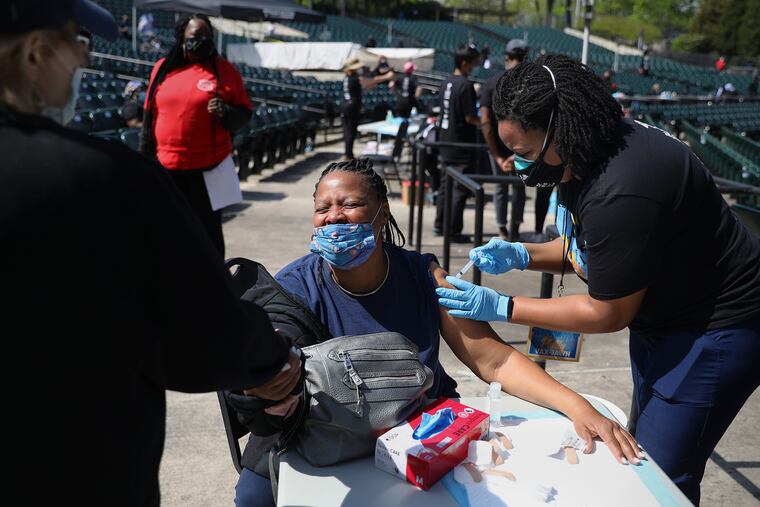What we know about ‘breakthrough’ COVID-19 infections in vaccinated people
Rare “breakthrough” COVID-19 infections after vaccination are to be expected — until so many people are vaccinated that the virus has nowhere to spread.

COVID-19 infections that occur in fully vaccinated people are rare, usually mild or asymptomatic, and probably less transmissible than infections in unvaccinated people, federal data and studies show.
Still, the idea of “breakthrough infections” is disturbing. Here’s what we know so far.
How is breakthrough infection defined?
Breakthrough cases are new infections occurring at least two weeks after full vaccination, because that’s when the immune system would be fully primed to prevent infection. The Pfizer and Moderna vaccines require two doses; Johnson & Johnson is a single shot.
The U.S. Centers for Disease Control and Prevention does not provide data on infections that occur in partially vaccinated people, or in the two weeks before the vaccines take full effect.
How effective are the vaccines?
The Moderna and Pfizer vaccines prevent more than 90% of infections in real-world use, studies show. They were about 95% effective in clinical trials. J&J’s shot, which went into use in March, had an overall efficacy of 66% in trials around the world.
» READ MORE: The COVID-19 vaccines are highly effective. Here’s what the numbers really mean.
All three vaccines completely prevented hospitalizations and deaths in the trials.
Even though the vaccines are highly effective, they are not perfect, which is why experts still advise masking and distancing in most indoor settings where exposure is possible.
How many breakthrough cases have occurred?
As of April 20, the CDC had received reports of 7,157 cases among more than 87 million fully vaccinated people, or 0.008%.
The agency cautioned that the real count is likely higher, because the reporting system is voluntary, and asymptomatic or mild cases may not be identified. “These surveillance data are a snapshot and help identify patterns and look for signals,” the CDC says.
Although most of those 7,157 cases had mild or no symptoms, the CDC listed 331 who needed hospitalization for COVID-19, including 77 who died. That means the risk of dying of COVID-19 after vaccination is about .0001%, or one in a million. The CDC estimates you are more likely to be struck by lightning in a year.
In contrast, the CDC estimates that for every million infections among the unvaccinated: 500 people ages 18-49 die; 6,000 people ages 50-64 die, and 90,000 senior citizens die.
» READ MORE: COVID-19 vaccine hesitancy is understandable. But the risks vastly outweigh the benefits.
What about high-risk settings such as skilled nursing facilities?
Even in such places, breakthrough infection seems to be rare.
A CDC study of 78 Chicago nursing homes found 627 breakthrough infections. Among those infections, only 22 were in fully vaccinated people — 12 residents and 10 staff members. Nearly two-thirds of breakthrough infections were asymptomatic, but two residents were hospitalized and one of them died — more evidence that old, frail people are particularly vulnerable to COVID-19.
Infections and deaths have plummeted in nursing homes across the country since December, when the Pfizer and Moderna vaccines were rolled out. However, vaccine hesitancy among frontline health care workers has remained stubbornly high. A CDC study of a Kentucky nursing home where only half the staff were fully vaccinated found that an unvaccinated worker launched an outbreak of 46 infections, including in 18 vaccinated residents and four vaccinated workers.
Will new coronavirus strains likely increase breakthrough infections?
Experts say the answer is yes — which is all the more reason to vaccinate as many people as possible as quickly as possible so the virus will have no place to spread.
In the Kentucky nursing home, the outbreak turned out to be driven by a virus variant carrying mutations that have been linked to greater transmission and evasion of the antibodies activated by vaccination.
Both Moderna and Pfizer have said they are working on booster shots that would foil key viral “escape” mutations.
Does vaccination prevent a person from transmitting the virus?
More research is needed, but it is clear that in breakthrough infections, the amount of virus is lower than in natural infections. The lower the viral “load,” the lower the chance of transmission.
“It is still not clear if vaccinated people can carry and transmit COVID-19 to non-vaccinated or immunocompromised people, but available data suggest that this risk is very small,” said Lewis Nelson, chair of emergency medicine at the Rutgers New Jersey Medical School. “I’ll caution that masks should still be worn. It is fully appropriate to progress in baby steps and assess the outcomes of each change.”